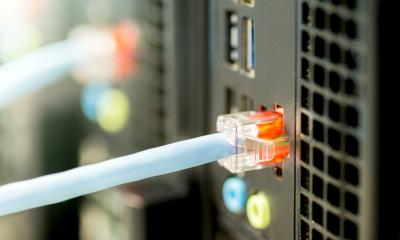
Your IT network connects all your devices, enabling you to share information, communicate and collaborate. Your network includes your computers, as well as all other equipment that can access it, including mobiles, tablets, and peripherals, such as printers. Your network is the lifeblood of your business, so understanding how it works is essential
To build an IT network you will need a range of equipment including the following:
- An internet connection. This is likely to be a fast fibre connection or dedicated leased line.
- Cables and connectors. Cables and connectors link the computers, printers, servers, and other equipment on your network. While you can go wireless, a wired internet connection through an Ethernet cable is stronger, more stable, and faster.
- A router. Your router manages network traffic, ensuring devices can communicate with each other via both wired and wireless (Wi-Fi) connections, and provides internet connectivity.
- A wireless access point (optional). A wireless connecter (Wi-Fi) enables people to connect to your network without wires. This will extend your wireless network if the router is incapable of offering coverage in certain parts of the building.
- A hardware firewall. This creates a secure barrier between your network and the internet, blocking security threats. Networks sometimes include an on-site network server which runs central applications, acts as an email server and provides file storage.
Network hardware building blocks
Some businesses base their network around cables because they're reliable and fast. The most common type is Ethernet cable, which is rated for speed. Cat 6 cables can carry data fast enough for any business purpose, including resource intensive processing tasks.
When building a network most businesses install network sockets at convenient locations throughout their premises enabling computer users to connect. Be sure to check that your computers can accept an Ethernet connection, as many laptops (including MacBook) don’t.
Win and keep customers
Track all customer enquiries and make sales simpler with CRM software. Find your perfect fit with these tools from our Donut partners.
The router: a vital network component
The router acts as a signpost, indicating where data on your network should go and enables devices to communicate with one another.
Routers also connect directly to the internet and share the connection via cable or Wi-Fi with devices on the network.
A basic router with four wired connections will cost from £70. A more advanced model, with 24 connections, could cost up to £300.
When investing in a router, check the security standard it uses, the number of wired connections it can support and how fast it is. You can check out user-reviews or speak to a professional who can help you select a suitable router.
Going wireless
Routers also include Wi-Fi capability, enabling people to connect laptops, smartphones, tablets and other devices to your network wirelessly.
Wi-Fi is ideal for providing network access to staff with mobile devices and in meeting rooms or common areas. It's also useful for offering internet access to visitors, with many routers including a separate 'guest' network for the purpose.
Wireless routers start at around £70.
Wi-Fi is essential for most modern business, particularly as more of us shift to a hybrid model with more of us working from laptops and tablets. Invest in a good quality router that can manage significant amounts of data at fast speeds, while providing high levels of protection.
Network equipment speeds
Most network equipment use common standards, so you can combine routers, cables, and firewalls from different manufacturers without any problems. However, the speed of your network might be governed by the slowest element. For example, if all your cables and computers are rated to Cat 6, your router must be rated to Cat 6 to deliver high speeds.
There are a several wireless networking standards commonly used although the majority of modern devices will include support for the latest versions. The maximum speed of a Wi-Fi network is indicated by its Wi-Fi 802.11 standard. When shopping for get a wireless router or access point rated to the latest Wi-Fi 6 standard (the common name for 802.11ax). It's the fastest available, delivering up to 2Gbps.



